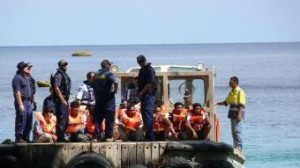Australia: Our chaotic asylum policy is an international embarrassment
By Jason Pobjoy, The Drum, Apr. 29 2011
The Labor government came into power with a commitment to reverse the legacies of the Howard government, which, according to the former Minister for Immigration and Citizenship, “had brought great shame on Australiaâ€. The government repeatedly emphasised that our international reputation has been “tarnished by the way the previous government sought to demonise refugees for its own domestic political purposesâ€, and committed to implement a policy framework that would bring Australia further into line with its international human rights commitments.
Initial signs were certainly promising.
In 2008 the government closed the offshore detention centres in Nauru and Papua New Guinea, strongly deriding the so-called “Pacific solution†as driven by “the cynical politics of punishing refugees for domestic political purposesâ€.
The former Minister for Immigration and Citizenship, Senator Chris Evans, launched a new set of detention values, which made detention a policy of last resort. In introducing that policy, Evans stressed that “[i]f a person is complying with immigration processes and is not a risk to the community then detention in a detention centre cannot be justifiedâ€. Of particular significance, the policy explicitly prohibited the detention of children in immigration detention centres, Evans acknowledging that “[t]he detention of children behind razor wire and the obvious damage done to them caused outrage in the Australian communityâ€.
The same year the government scrapped the Temporary Protection Visa regime, decrying it as “one of the worst aspects of the Howard government’s punitive treatment of refugeesâ€. Senator Chris Evans described the regime as “inhumane, unfair and ineffectiveâ€.
By the end of 2008, Australia was well on its way to restoring its status as a “credible international actor in the field of refugee protectionâ€.
So, where are we now?
The government is currently negotiating with East Timor to introduce a “regional solution†for the processing of refugees applicants. In the words of the Prime Minister, “a boat ride to Australia would just be a ticket back to the regional processing centre.†Although details remain hazy, one would certainly be forgiven for noting the similarities to the “Pacific solution†that the Labor government had, at least initially, so ardently distanced itself from.
As at 11 March 2011 there were 6,819 people in immigration detention, 4304 on the mainland and 2515 on Christmas Island. Significantly, at least 769 children remain in immigration detention (albeit under the guise of “alternative temporary detentionâ€). In stark contrast to the values promoted by the government in 2008, immigration detention remains mandatory and indefinite. 5743 of applicants had been detained for more than 3 months. Rather than looking for alternative solutions, the government has expanded its detention program, reopening the infamous Curtin detention centre in 2010, and last month announcing the construction of a new facility in southern Tasmania.
Meanwhile, conditions in detention facilities continue to deteriorate, with significant financial and human costs. In the past eight months there have been at least seven deaths in immigration detention. Five of these were suicide.
We are also seeing increased unrest amongst detainee populations, protesting against languishing conditions and increasing delays. At the time of writing three refugee applicants are refusing to come down from the roof of the Villawood Immigration Detention Centre, an applicant detained on Christmas Island has sewn his lips together, and a hunger strike at Curtin Immigration Centre entered its fourth day.
And now, in response to the heightened unrest, Temporary Protection Visas look set to make a comeback.
Australia’s schizophrenic refugee policy was already an international embarrassment – but Immigration Minister Chris Bowen’s announcement on Tuesday that the government is seeking to (re)introduce temporary visas for asylum seekers who riot in immigration facilities, is surely a new low.
Although Bowen has been careful to avoid the formal language of Temporary Protection Visas, the practical effect is ostensibly the same. An individual granted a temporary visa would have no travel rights, reduced access to services, could not be reunited with family members, and would be more susceptible to return to their country of origin.
This enforced state of limbo was explicitly denounced by the current government and human rights organisations around the world, and widely regarded as a violation of Australia’s obligations under the Refugee Convention and other international human rights treaties.
Although not seeking to excuse the damage recently caused by rioting in immigration facilities at Villawood and Christmas Island, the government needs to take some responsibility for the current situation. It is, in many ways, a product of its own making.
These men, women and children have not chosen to be refugees; they are victims of some of the most brutal and devastating regimes who have, against all odds, reached Australian shores in search of surrogate protection. Rather than treating them with the dignity and compassion they deserve, we lock them up in overcrowded facilities, for an indeterminate period of time.
And now, if they dare speak out, dare complain, we will (retrospectively) impose punitive sanctions, denying the rights to which they are legally entitled as refugees.
Far from securing its place as a credible international actor, this most recent proposal can only further increase the chasm between Australian refugee policy and internationally accepted practice.
It must be rejected.
Jason Pobjoy is an Australian lawyer, PhD candidate at the University of Cambridge, and a visiting fellow at New York University School of Law. His research focuses on the treatment of child refugees.




